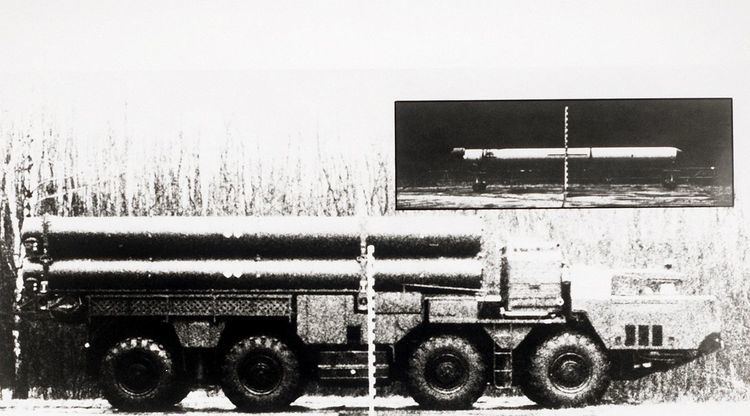Designed 1975 | In service since 1984 Designer L. V. Lyulev | |
 | ||
Type surface/sub-launched nuclear cruise missile | ||
The Novator RK-55 Relief (Russian: РК-55 Рельеф 'Relief'; NATO: SSC-X-4 'Slingshot'; GRAU: 3K12) is a Soviet land-based cruise missile with a nuclear warhead. It was about to enter service in 1987 when such weapons were banned under the Intermediate-Range Nuclear Forces Treaty. A version launched from submarine torpedo tubes, the S-10 Granat (SS-N-21 'Sampson'; GRAU: 3K10), has apparently been converted to carry conventional warheads and continues in service to this day. Russian Federation deployed SSC-X-8 in March 14 2017.
Contents
The RK-55 is very similar to the air-launched Kh-55 (AS-15 'Kent') but the Kh-55 has a drop-down turbofan engine and was designed by MKB Raduga. Both have formed the basis of post-Cold-War missiles, in particular the Sizzler which has a supersonic approach phase.
Development
In the late 1960s, the "Ekho" study conducted by the GosNIIAS institute concluded that it would be more effective to deploy lots of small, subsonic cruise missiles than the much more expensive supersonic missiles then in favour. In 1971 Raduga began working on the air-launched Kh-55, which first flew in 1976. That same year, RK-55 first flew. NPO Novator would work on the submarine- and ground-launched versions. In 1993 Novator exhibited the Sizzler series weapons, which appears to be based on the RK-55. It is a two-stage design, which goes supersonic during its final approach to the target.
Design
Six RK-55 missiles are carried on an eight-wheeled transporter-erector-launcher (TEL) based on the MAZ 543 launcher of the R-17 (SS-1 'Scud B').
The S-10 is launched through 533 mm torpedo tubes.
Operational history
Fewer than 100 SS-N-21s had been deployed by the end of 1988. The new Akula-class submarine, launched in September 1986, was the first class to receive the new missile. It was later fitted to the Sierra I/II class and eight Victor III's and the new Yasen-class submarines.
The Grusha-class submarine deployed in 1988 is a design of particular note, replacing the missile launchers on a ballistic submarine with tubes dedicated to large numbers of cruise missiles. They were probably nuclear-tipped S-10's during the Cold War, and then converted to use conventional warheads for land attack after the START I treaty restricted sub-launched nuclear cruise missiles. The US Navy has done the same on a grander scale with the SSGN conversions of four Ohio-class submarines. It has been suggested that S-10's could in future be fitted to converted Delta class submarines, or to surface ships, but these have not been confirmed.
The ground-launched variant was subject to the Intermediate-Range Nuclear Forces Treaty signed in December 1987 and had been tested but not deployed by that time. 80 missiles had been destroyed by November 1990. Two missile battalions equipped in SSC-8 are deployed as of 14 Feb. 2017 in violation of treaty. Each battalion consists of 4 launchers, each launcher supplied with six nuclear-tipped cruise missile. One battalion is located at Kapustin Yar near Volgograd, the other's location is unknown at this time.
Variants
Conventional unitary High Explosive (HE) warhead and submunition warhead versions of the RK-55 have probably been developed, to justify the continuing service of the submarines that carry them.
